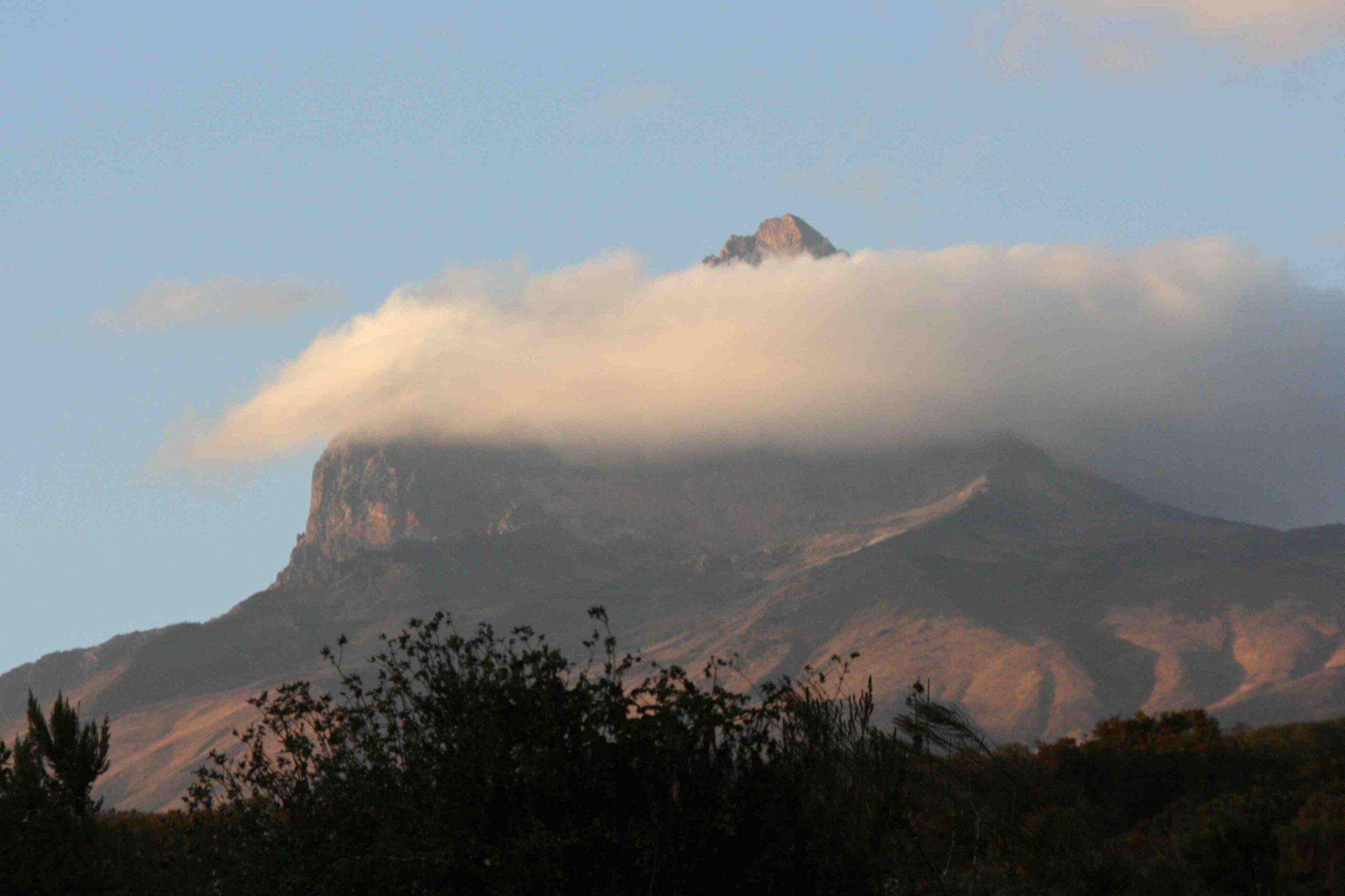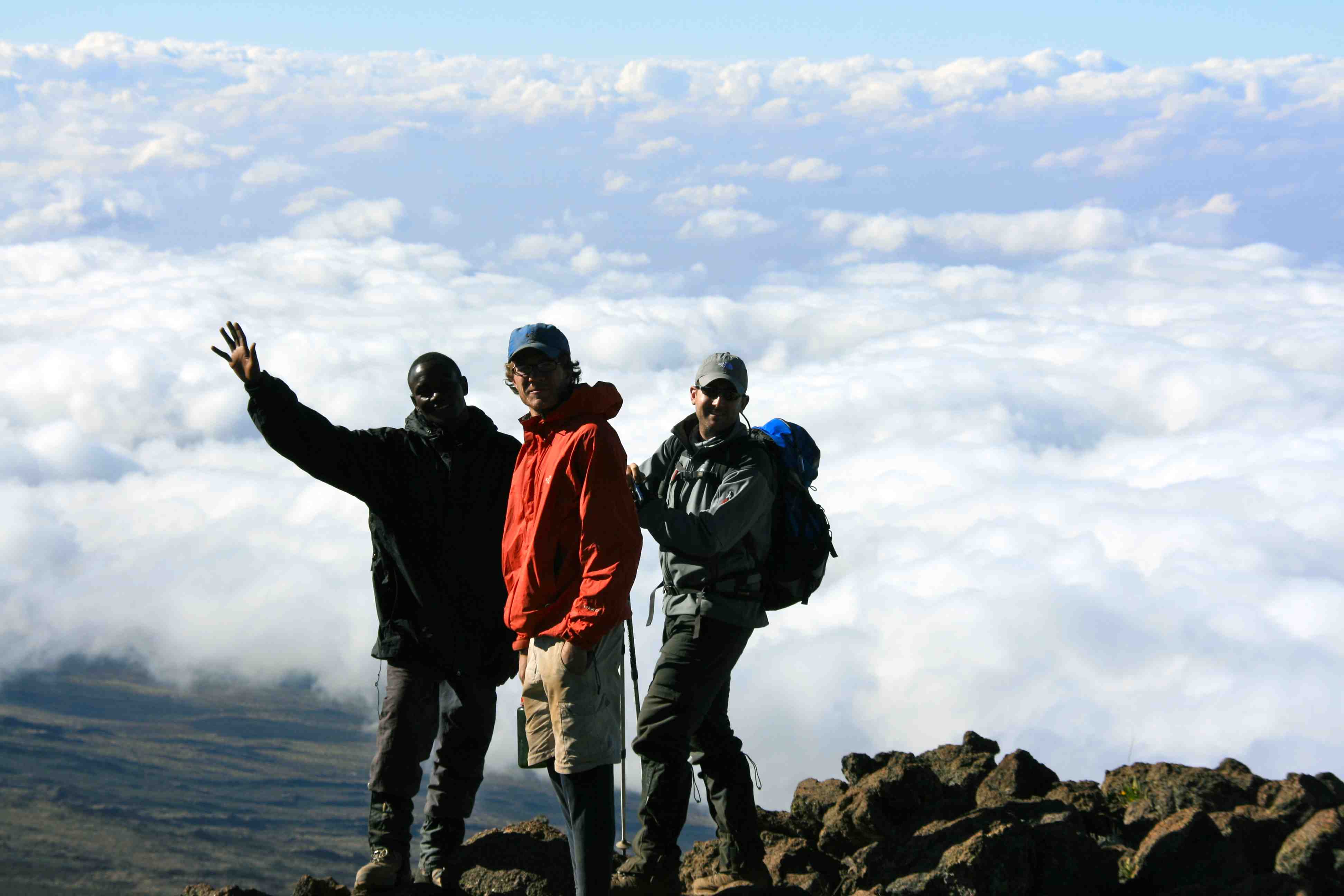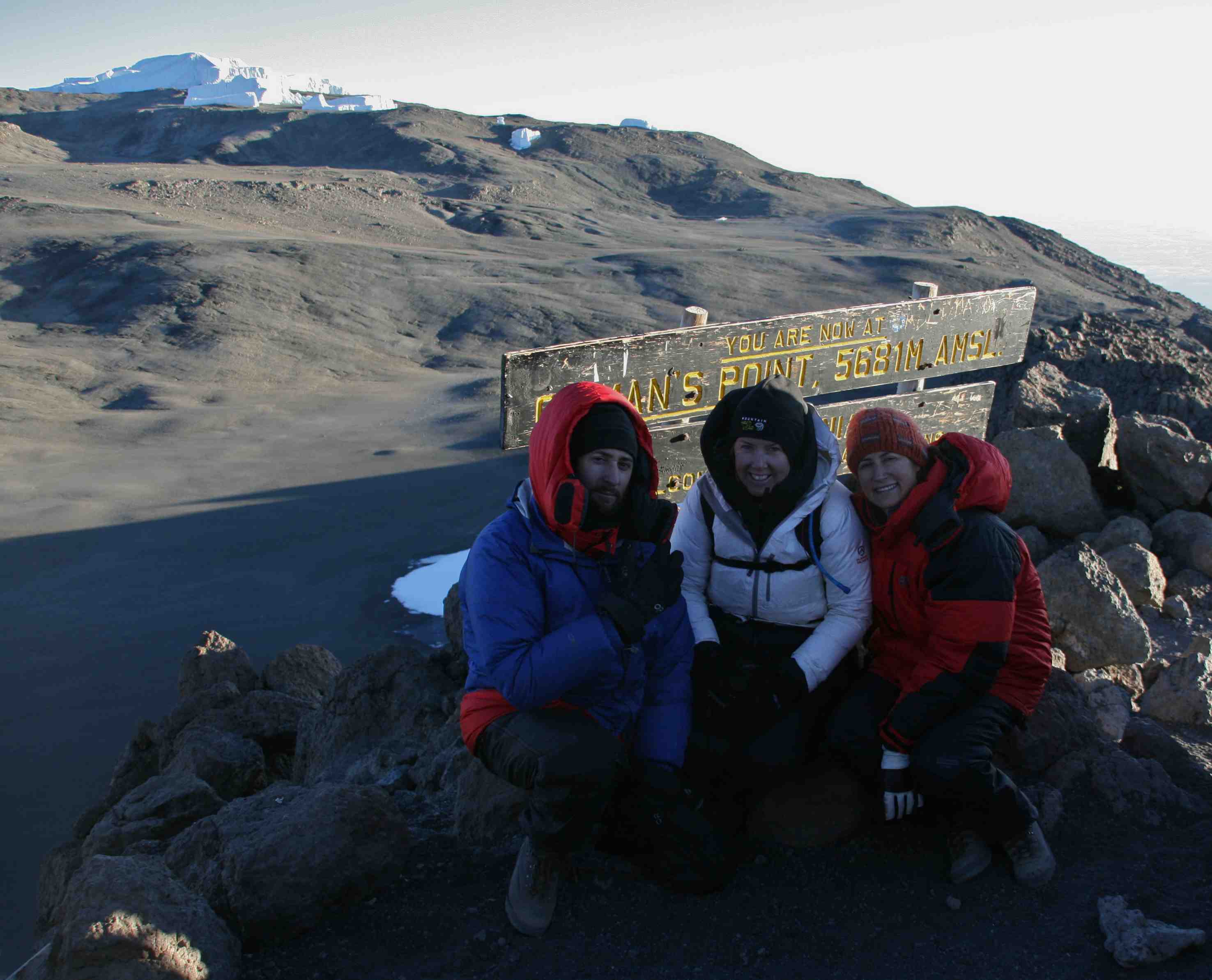“It's not a hike at all; it's a personal journey,” Brennan says as we sit clutching hot coco in our mess tent with two pairs of gloves on, teeth still chattering. It's 11 p.m. and -4 degrees Fahrenheit outside the tent, and we're on the verge of climbing Mt. Kilimanjaro.
We wear everything we own, five layers of pants, six layers of shirts and jackets, to the “Last Supper” before beginning the summit push at midnight.
Twelve of us had come this far, hiking four days to 15,500 feet to Kibu Hut. Now, it was time to summit Mt. Kilimanjaro, and at 19,330 feet, not all of us would make it.
Tonight, tonight is where you feel the mountain; tonight, it is you against the mountain. Everyone wants to reach the top for their own personal reasons, having their own personal odyssey.
Climbing Mt. Kilimanjaro has been a trek to self-awareness, climaxing tonight, the push to the summit. You versus the mountain, and who is going to win?
It was only yesterday I sat on the edge of the earth, on top of brownish-red volcanic rocks, staring at the jagged peaks that form Mawenzi Peak (16,890 feet), one of Kilimanjaro's three dormant pinnacles.
The saw tooth crests, which started so far away as a tiny apex just three days ago in the distance, are now upon me, and I have walked to see them up close and personal.
A few people have tried to summit Mawenzi Peak, but they have all failed or died trying, as the rocks are volcanic and crumble easily.
Turning around and dangling my legs over the rocks, I look down onto the endless ocean of white fluffy clouds and watch the ever-changing, endless cloud formations under my feet.
The Buddhists say, “Clouds are like thoughts.” I see the truth in this; some thoughts are thick and heavy, some are light and fluffy, some quick to form and ever-changing.
They are real and imaginary all at the same time, and both are fields of energy. From here, it looks like you could float on top of the billows, as they seem to have matter to them, substance, and depth.
But they don't, just like thoughts. The barren valley landscape with clouds drifting to infinity is what heaven must look like, and these are the gates to paradise.
Looking around from the vast white sea where vegetation is sparse, the dry landscape should be covered with snow this high up at 13,800 feet, but man's actions have deprived the peaks of moisture.
Soon, none of Kilimanjaro will have snow on it. The glaciers will have all melted. It is a clear representation of global warming and our direct effect on this planet.
Mt. Kilimanjaro is the most accessible of the seven summits for tourists to climb, offering a few different routes, accommodations, and amount of days on the trip.
I choose to do the Rongai Route, which is a 6-day hike, on the easier end of the spectrum, with camping in tents.
Although it's the highest, most walkable mountain in the world, with its gently sloping topography until the last day, where the trek to Gillman's Point is a steep climb to a plateau top of Kibu Summit, fitness is critical, and walking 6-8 hours a day is not uncommon.
My guide company, Africa Travel Resource, subcontracts out to The African Walking Company, which is highly regarded for its skillful guides, excellent service, and high success rate of clients reaching the summit.
AWC led the Red Nose Climb, a trip of British celebrities that climbed Mt. Kilimanjaro for charity. Matthew, a 22-year-old Brit in our group, even slept in Cheryl Cole's sleeping bag!
In order to reach this magical place above the ocean of white, we scrambled upwards for three hours and watched the landscape reshape before our eyes from vegetation to volcanic rocks, flowers, and birds to nothing except for the everlasting flower.
True to its name, the everlasting flower can withstand all conditions. Passing through four different microclimates makes hiking Mt. Kilimanjaro so unique: rainforest, savannah, glacial, and high desert.
Samuel, our 55-year-old guide, who has been leading treks (and consequently smokes cigarettes during breaks as we are panting and struggling for breath) for over 20 years, sets the pace.
The local mantra is “pole pole,” which means “slowly, slowly.” Altitude acclimatization is essential. However, it is too pole-pole for me as one of the stronger in the group, along with Henry, a professional trekker and medical student.
We converse with the guide to see if we can go ahead just a little bit so we're not tripping over the rest of the group, and he obliges.
I understand the purpose of going slow and know I need to stay with the group, but frustration can get the best of me. However, “pole-pole” is a good life lesson.
Not everything in this world needs to happen now or quickly. Everything happens in its own due time, and I need to respect that.
As Americans, we are accustomed to our fast-paced society, and everything is now, now, now, but the rest of the world does not work on our time schedule.
It's good to slow down, to be able to look left and right as I'm hiking. Since I am going so slowly, I can appreciate the views, breathe everything in, lift my head up so I can see the world around me, feel what's in the air, and see the horizon.
It's midnight, and we all queue up, frost hanging on every visible breath, headlights spotted to emulate a small circle in front of us, walking sticks in hand, as we start the six-hour pilgrimage to the top.
The sky bearing down on us, the darkness surrounding us, and the stars illuminating the sky, our group trudges upward, scree underneath our feet.
Utter silence except for the guides singing melodious African songs keeping us focused and aligned with them and the universe.
Following the stars, I think about being one with nature and observing the natural forces of things, and that events are not random and situations shouldn't be judged as good or bad.
On that mountain, nothing else in the world matters except putting one foot in front of the other.
And if nothing else matters, then I should concentrate on just living in the present, in what is happening right now, opening myself up to feel every experience rather than just having the experience.
The star-filled night was definitely cold, my feet and fingers ringing from numbness, but I actually had on too many layers and began to feel warm.
The altitude sickness hits, and the weight of the mountain is revealed. I felt dizzy, couldn't walk straight, very lightheaded, and felt my mind start to lose focus.
I was hot and didn't like the Balaclava (a ski mask-like item of clothing). My legs turned to jelly and mush. But I could view the immense beauty creating the night and began concentrating on the stars.
I followed the outline of the Kibu Summit against the glow of the backdrop of the universe, and as I continued upwards, the outline and the curvature of the earth would change. I knew time was passing, and I was gaining altitude.
The magnificence of the night sky was engulfing us along the mountain. Some people from the group didn't even notice the stars or the sky, and all they did was look down at their feet, counting steps.
I don't want to live that way anymore. I don't want to look down all the time and not see anything that's going on around me.
I want to open my eyes and see, to look around and view the outline of mountains in the darkness, the brightness of the stars, the tiny pebbles slogging underneath my feet.
The mental game in climbing Mt. Kilimanjaro really begins, trudging along for hours uphill in silence.
Can I zig-zag up a mountain, not even really on a path, just sludging through loose gravel for six hours in the middle of the night at -4 degrees Fahrenheit, with the altitude affecting me in many different ways?
It was a mental game against myself, and at times I was losing. I envisioned turning around, as Martin and Fiona had, feeling so sick and wanting to vomit anytime I ate anything, but I had to keep up the energy. Failure was not an option.
About two hours into the hike, I couldn't imagine doing this for another four hours, but after three hours in, I thought, ” Well, I can't go back as it's just as far to go back as it is to finish it up. “
And so I dragged on, this lunar landscape, scree underneath my feet. Suddenly, Henry halted in front of me, pointing to the night sky, “Look, a shooting star!”
A big white ball of illumination flew across the heavens. I knew then that the universe was taking care of me, and it gave me the strength to carry on.
Finally, there were less than two hours left, and I knew I would reach the top. Around 5:30 a.m., the sky was getting just a bit brighter, and the first light was close.
My energy shifted, adrenaline kicked in, and I had a second wind, with actual spring to my step as we scrambled thick boulders.
Paulo Coelho sums it up best in The Valkeries, “I died, and I was reborn again.”
The mountain kicks your ass, drags you down, beats you and sucks every ounce of life and energy out of you, and basically leaves you for dead, and then the light comes and revitalizes your heart, mind, and soul.
Out of the darkness, the sun started to rise about 20-25 min before we reached the pinnacle, the orange and red peaking out of the black to outline the Mawenzi Peak.
As Brennan said the day before, “I better see God up there,” and I believe we did, looking towards Mawenzi Peak, lit in golden light and peering down onto infinite white clouds. And tears flowed out of me like a faucet.
Overcoming such obstacles and conquering the mountain, I stood on the top and had a look around. I had reached the roof of Africa.
Climbing Mt. Kilimanjaro is a very humbling experience. It essentially strips the roles in which we identify: husband, wife, mother, father, profession, class, social status, the city you live in, etc.
It peels away your ego and forces you to look inside yourself, really see what you are made of, and find out who you are on the inside. All that's left is YOU and the mountain.
As Hassan, the psychotherapist on the trip, said, “You climb the mountain from the outside and the inside.”
____________
About the Author: Lauren Becker is a filmmaker turned travel writer who has been lucky enough to travel the world for work and fun. She enjoys sharing her experiences through the written word, the still photograph, and moving images. Read more at her personal website, my personal website is www.laurenbecker.net, or follow her on Twitter @filmlb.
This post was written by a guest contributor. Please reference the author's byline in the post above for more information. If you would like to guest post on Go Backpacking, please read our submission guidelines. For information on advertising opportunities, go here.
Planning a trip? Go Backpacking recommends:
- G Adventures for small group tours.
- Hostelworld for booking hostels.







Cissa
Wednesday 29th of February 2012
Beautiful and inspiring article. Something to remember and to take strength from when my time to climb Kili comes.
Connor
Sunday 18th of December 2011
Great post on Mount K. I claimed it myself a few months ago. It's a great adventure and provides some of the best views over Africa. [link removed]
Hope it helps.
Kilimanjaroexpeditions
Monday 8th of August 2011
Very wonderful kilimanjaro climbing travelogue
Dylan
Thursday 20th of January 2011
I've wanted to do this hike for a long time! Thanks for the post!
kurt
Monday 27th of September 2010
nice post and nice pics..